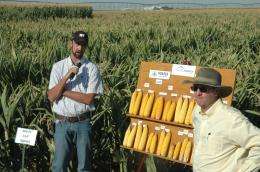AgriLife Research project shows maximum irrigation and plant populations not necessary for corn

Corn research studies conducted at the North Plains Research Field near Etter are showing that maximum irrigation and high plant populations don’t always produce the most economical or water-use efficient yields.
Dr. Brent Bean, Texas AgriLife Extension Service agronomist, along with Jake Becker, Texas AgriLife Research technician and graduate student, are studying new drought-tolerant corn hybrids under different seeding and irrigation rates.
The Texas High Plains Water District, along with Pioneer and Syngenta seed companies, are helping fund this study.
The goal of the study is to determine how to best manage these new drought-tolerant corn hybrids under limited irrigation.
“All of the major seed companies are working on drought tolerance, and we are looking at what is considered the first generation of these new drought-tolerant hybrids,” Bean said.
The study compares the new drought-tolerant hybrids to conventional hybrids. It is important that these new hybrids yield well under reduced irrigation, but also have the ability to not limit yield when favorable conditions are present, he said.
“We have four hybrids from each of the companies, and will be comparing each company’s drought-tolerant hybrids to their conventional hybrids,” Bean said. “It is not our intention to compare the two company hybrids against each other; in fact, they are being conducted in separate trials.”
Becker said Pioneer’s drought-tolerant hybrids are being sold under the brand AquaMax, while Syngenta’s drought-tolerant hybrids are under the Artesian brand.
In the study, the hybrids are being grown at irrigation levels ranging from 40 percent to 100 percent evapotranspiration levels, he said.
Evapotranspiration is the loss of water from the soil both by evaporation and by transpiration from the plants. The irrigation levels are adjusted to replace that water loss on a percentage basis, Bean said.
“You can really see the effects of the different irrigation levels in ear length, number of rows of kernels and overall pollination,” Becker said.
The amount of irrigation water applied to meet the various percentages of evapotranspiration were: 40 percent, 14.13 inches; 50 percent, 16.29 inches; 65 percent, 20.33 inches; 75 percent, 23 inches; and 100 percent, 29.71 inches.
There was a clear height difference between all the levels, with the exception of 75 percent and 100 percent evapotranspiration, Becker said, and he didn’t expect there to be a big yield difference between those two levels.
As for the other levels, he said so far all are producing ears with kernels. The 50 percent level has short plants, but it still pollinated and is producing ears. The 65 percent level showed better pollination, longer cob length and more kernels, as expected.
“This research is just getting started, but this year’s data should provide us with good information on the performance of these new drought-tolerant hybrids under limited irrigation and the extreme weather conditions experienced this summer,” Becker said.
Provided by Texas A&M AgriLife















